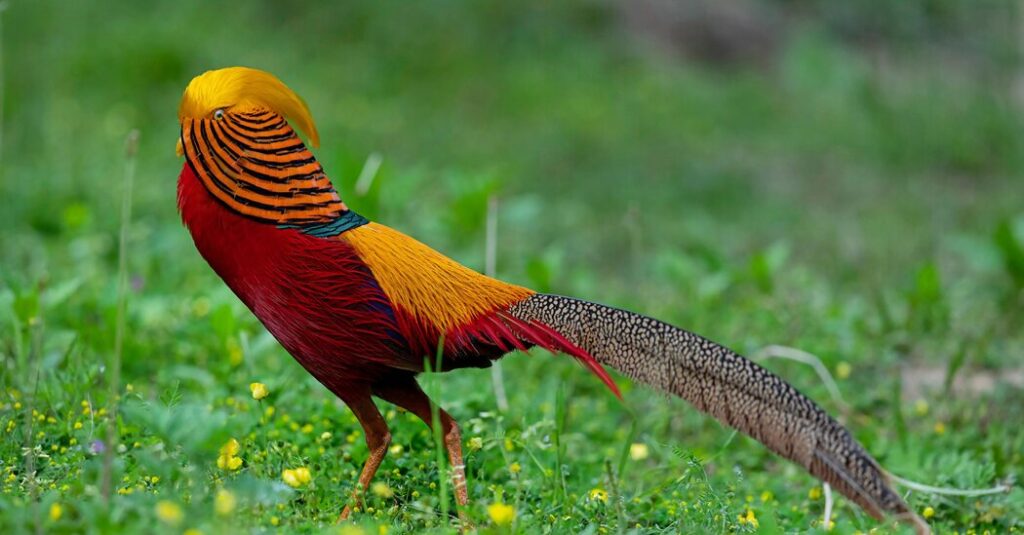To woo mates, male golden pheasants are dressed to impress. The game birds strut around with cinnamon-colored tail quills and a striped hood of orange and black feathers. Then there is its forehead crest of yellow plumage that is slightly reminiscent of a certain politician’s slicked-back coiffure.
It turns out that it really isn’t easy to look that good. In a paper published on Wednesday in the journal Biology Letters, scientists discovered that the facial feathers of male golden pheasants decrease their field of vision. It is the first evidence of a bird where sexes see the world differently.
“Looking this good comes with a cost,” said Steve Portugal, a biologist who studies animal behavior at the University of Oxford and who is an author of the new paper. “This amazing hairdo cuts out a large portion of their vision.”
Dr. Portugal and his colleagues stumbled across the discovery while studying avian vision to determine why some species were prone to flying into man-made structures like wind turbines. The team studied vision in around 300 species and discerned no difference in eyesight based on sex. But when the scientists tested golden pheasants, they were surprised to observe differences in the visual capabilities of males and females, who lack those showy hoods and facial feathers.
To confirm the initial findings, the team visited private bird collections in France and England that were home to golden pheasants and their close relatives, Lady Amherst’s pheasants. Those avian showmen have a colorful hood and are covered in white, black and dark green feathers that are arranged like shimmering scales. The team also examined the vision of more distantly related silver and green pheasants, who possess less extravagant feather structures on their heads.
To test the pheasants’ vision, the team strapped both males and females onto a foam cradle and outfitted them with a silicone beak holder to keep their heads steady. The scientists then used an ophthalmoscope, which eye doctors use to examine the inner eye. They shined a light into the pheasants’ peepers and recorded how it reflected off the birds’ retinas. Shining the light from several different angles around the pheasants’ heads allowed the researchers to map the boundaries of the birds’ vision.
The results revealed that male golden and Lady Amherst’s pheasants saw significantly less than their female counterparts. The team determined that the male pheasants had a blind spot 137 percent larger than those observed in females. In contrast, pheasant species with more subdued plumage exhibited no differences in vision between males and females, supporting the hypothesis that the flashy facial feathers of golden and Lady Amherst’s pheasants block their sight.
The male pheasants’ blind spots primarily obscured the top of their visual field, like a person trying to peer through overgrown bangs. The feather crest decreased the male birds’ field of vision by at least 30 percent compared with that of females.
According to Dr. Portugal, this is particularly disadvantageous for birds like pheasants, which spend much of their time looking at the ground to feed on lizards, insects and berries. The facial feathers would make it difficult for a feeding pheasant to detect an approaching fox or cat. And unlike well-camouflaged female pheasants, males don’t have the ability to hide. “If you’re a male golden pheasant, you may as well have confetti and a feather boa on,” Dr. Portugal said.
According to Anne Peters, a behavioral ecologist at Monash University in Australia who was not involved in the new study, the increased risk of predation for visually impaired male pheasants is most likely worth it. “The presumption is that they confer a mating advantage through greater attractiveness to choosy females,” she said. If the flamboyant feather crests increase the amount of offspring the male pheasants can father, the trait will continue to be favored.
Several other species of birds exhibit similarly extreme ornamentation on their heads, usually in the form of bony casques or oversize wattles. Dr. Peters wonders if these structures also hamper vision.
Dr. Portugal agrees, and his team already has a dream subject in mind: birds-of-paradise. Like golden pheasants, male birds-of-paradise are always overdressed. “They look like a Disney cartoon with these crazy outfits and feathers,” he said. “The males are so busy showing off I wouldn’t be surprised if they could barely see.”
The post He’s Beautiful, but He Has a Huge Blind Spot appeared first on New York Times.




